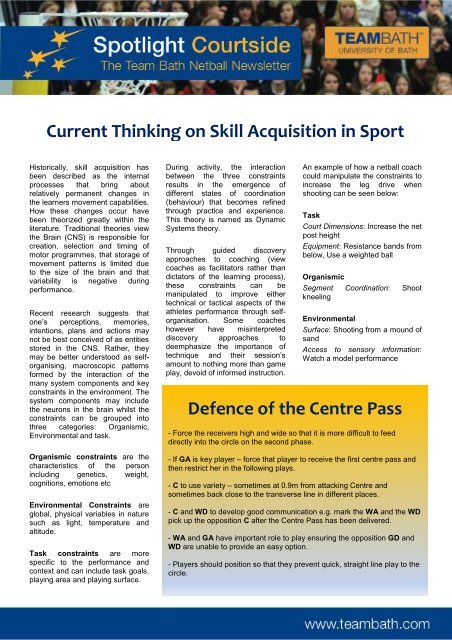Team-Bath-Netball-Newsletter-November-2012
Team-Bath-Netball-Newsletter-November-2012
Team-Bath-Netball-Newsletter-November-2012
You also want an ePaper? Increase the reach of your titles
YUMPU automatically turns print PDFs into web optimized ePapers that Google loves.
Current Thinking on Skill Acquisition in Sport<br />
Historically, skill acquisition has<br />
been described as the internal<br />
processes that bring about<br />
relatively permanent changes in<br />
the learners movement capabilities.<br />
How these changes occur have<br />
been theorized greatly within the<br />
literature. Traditional theories view<br />
the Brain (CNS) is responsible for<br />
creation, selection and timing of<br />
motor programmes, that storage of<br />
movement patterns is limited due<br />
to the size of the brain and that<br />
variability is negative during<br />
performance.<br />
Recent research suggests that<br />
one’s perceptions, memories,<br />
intentions, plans and actions may<br />
not be best conceived of as entities<br />
stored in the CNS. Rather, they<br />
may be better understood as selforganising,<br />
macroscopic patterns<br />
formed by the interaction of the<br />
many system components and key<br />
constraints in the environment. The<br />
system components may include<br />
the neurons in the brain whilst the<br />
constraints can be grouped into<br />
three categories: Organismic,<br />
Environmental and task.<br />
Organismic constraints are the<br />
characteristics of the person<br />
including genetics, weight,<br />
cognitions, emotions etc<br />
Environmental Constraints are<br />
global, physical variables in nature<br />
such as light, temperature and<br />
altitude.<br />
Task constraints are more<br />
specific to the performance and<br />
context and can include task goals,<br />
playing area and playing surface.<br />
During activity, the interaction<br />
between the three constraints<br />
results in the emergence of<br />
different states of coordination<br />
(behaviour) that becomes refined<br />
through practice and experience.<br />
This theory is named as Dynamic<br />
Systems theory.<br />
Through guided discovery<br />
approaches to coaching (view<br />
coaches as facilitators rather than<br />
dictators of the learning process),<br />
these constraints can be<br />
manipulated to improve either<br />
technical or tactical aspects of the<br />
athletes performance through selforganisation.<br />
Some coaches<br />
however have misinterpreted<br />
discovery approaches to<br />
deemphasize the importance of<br />
technique and their session’s<br />
amount to nothing more than game<br />
play, devoid of informed instruction.<br />
An example of how a netball coach<br />
could manipulate the constraints to<br />
increase the leg drive when<br />
shooting can be seen below:<br />
Task<br />
Court Dimensions: Increase the net<br />
post height<br />
Equipment: Resistance bands from<br />
below, Use a weighted ball<br />
Organismic<br />
Segment Coordination: Shoot<br />
kneeling<br />
Environmental<br />
Surface: Shooting from a mound of<br />
sand<br />
Access to sensory information:<br />
Watch a model performance<br />
Defence of the Centre Pass<br />
- Force the receivers high and wide so that it is more difficult to feed<br />
directly into the circle on the second phase.<br />
- If GA is key player – force that player to receive the first centre pass and<br />
then restrict her in the following plays.<br />
- C to use variety – sometimes at 0.9m from attacking Centre and<br />
sometimes back close to the transverse line in different places.<br />
- C and WD to develop good communication e.g. mark the WA and the WD<br />
pick up the opposition C after the Centre Pass has been delivered.<br />
- WA and GA have important role to play ensuring the opposition GD and<br />
WD are unable to provide an easy option.<br />
- Players should position so that they prevent quick, straight line play to the<br />
circle.


